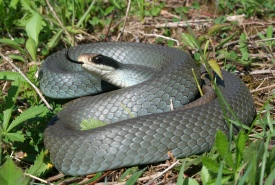
Blue racer (Photo by Joe Crowley)
Blue racer
What does it look like?
The blue racer, a non-venomous snake, is the second longest snake species in Ontario, growing up to two metres in length. It is named for its ability to reach speeds of up to seven kilometres per hour, and its grayish blue or blue-green colour. Its underside is a lighter blue-green or whitish blue, and its eyes are surrounded by a dark “mask.”
Where does it live?
In Canada, the blue racer is only found on Pelee Island, Ontario, in western Lake Erie. Historically, it also occurred at Point Pelee National Park and near Grand Bend. In the U.S., it ranges from Iowa east to Ohio.
This snake prefers open to semi-open areas, such as alvar and open woodland, as habitat. They also use forests in the heat of the summer. Like many snake species, it hides under rocks and logs, and it basks in the sun to help regulate its body temperature. Females lay their eggs in rotting logs, compost piles, stumps, under rocks or in animal burrows. During winter, blue racers hibernate below the frost line in rock crevices, burrows and human-made structures, such as old foundations. They hibernate communally and may share their hibernation sites with other snake species.
What is this species’ conservation status?
Canada’s Species at Risk Act lists the blue racer as endangered. Threats to this species include habitat loss or degradation, loss of overwintering sites and road deaths.
What is NCC doing to protect habitat for this species?
The Nature Conservancy of Canada (NCC) has protected 404 hectares (998 acres) on Pelee Island — 10 per cent of the island’s total area. Between NCC and other conservation organizations, 18 per cent of the island is protected, including most of the blue racer’s key habitat.
In addition to protecting critical habitat for the blue racer, NCC is restoring foraging, basking, nesting and hibernation sites for this endangered species. Active restoration of agricultural fields by creating wetlands and planting native wildflowers and grasses on NCC lands has increased total natural habitat by 56 hectares (138 acres). Ongoing removal of invasive species is helping to open up habitat and maximize native plant and insect diversity, improving habitat for racers and other native species, both common and rare.





